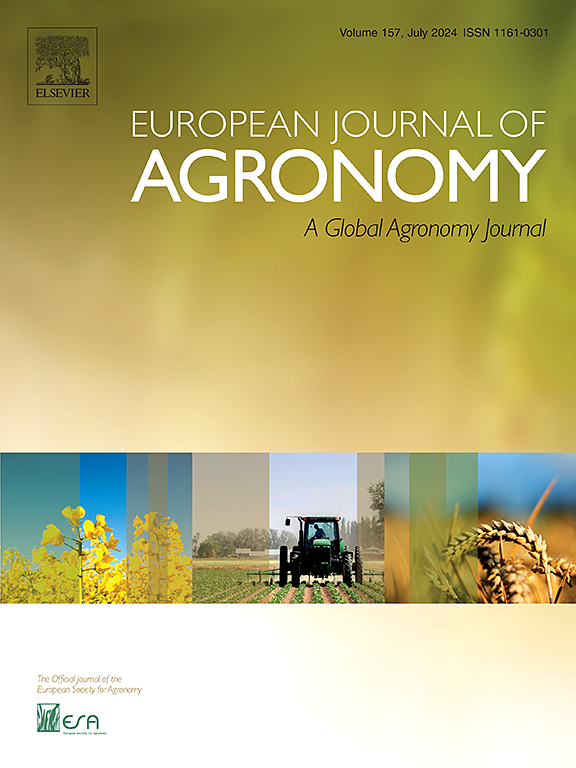Forecasting of large-scale tea anthracnose in mountainous region of China though integration of multi-source habitat information with spatiotemporal phenological corrections
IF 5.5
1区 农林科学
Q1 AGRONOMY
引用次数: 0
Abstract
Accurate large-scale forecasting of tea anthracnose (TA) (Colletotrichum camelliae) is crucial for tea cultivation disease management. TA infection exhibits a strong synchrony with phenological development regulated by accumulated growing degree days (AGDD). However, the complex microclimatic conditions of mountainous regions lead to highly heterogeneous spatiotemporal phenological response patterns in tea plants, posing significant challenges to the effective extraction and utilization of habitat factors in disease forecasting models. To address these issues, this study proposes a novel forecasting approach for TA by integrating multi-source habitat information with spatiotemporal phenological corrections. Using survey data on TA collected in Zhejiang Province from 2016 to 2020, a spatiotemporal phenological correction strategy based on AGDD was developed. This strategy facilitated the alignment of AGDD-calibrated multi-source habitat data to construct a comprehensive feature dataset for disease forecasting. A forecasting model was subsequently developed through the application of the Relief-F algorithm for feature selection, combined with representative machine learning techniques, including Support Vector Machine (SVM), Random Forest (RF), k-Nearest Neighbor (KNN), and Naive Bayes (NB). The results demonstrated that the strategy combining RF with AGDD-aligned multi-source features significantly enhanced forecasting performance, achieving an average overall accuracy (OA) of 77 % and an average kappa coefficient of 0.65. This approach outperformed conventional methods using either calendar-aligned features or single meteorological factors combined with machine learning algorithms. From a spatiotemporal heterogeneity perspective, this study elucidated the response characteristics of multi-source habitat factors under varying geographical and terrain conditions using the AGDD-aligned phenological correction strategy. Furthermore, the integration of remote sensing data, which reflects the physiological state of tea plants, with meteorological and geographical factors substantially improved the comprehensiveness and precision of TA forecasting. These findings highlight the importance of incorporating spatiotemporal phenological corrections and multi-source habitat data for advancing disease forecasting methodologies in complex agricultural landscapes.
基于多源生境信息和时空物候校正的中国山区大规模茶炭疽病预测
茶炭疽病(Colletotrichum camelliae)的大规模准确预报对茶叶栽培病害管理至关重要。TA侵染与物候发育具有很强的同步性,受累积生长日数(AGDD)的调控。然而,山区复杂的小气候条件导致茶树时空物候响应模式高度异质性,对病害预测模型中生境因子的有效提取和利用提出了重大挑战。为了解决这些问题,本研究提出了一种将多源栖息地信息与时空物候校正相结合的TA预测方法。利用2016 - 2020年浙江省TA调查数据,提出了基于AGDD的时空物候校正策略。该策略促进了agdd校准的多源栖息地数据的对齐,以构建一个全面的疾病预测特征数据集。随后,通过应用Relief-F算法进行特征选择,结合代表性的机器学习技术,包括支持向量机(SVM)、随机森林(RF)、k-近邻(KNN)和朴素贝叶斯(NB),开发了一个预测模型。结果表明,将射频与agdd对齐的多源特征相结合的策略显著提高了预测性能,平均整体准确率(OA)为77 %,平均kappa系数为0.65。这种方法优于使用日历对齐特征或单一气象因素结合机器学习算法的传统方法。从时空异质性角度出发,利用与agdd对齐的物候校正策略,阐明了不同地理地形条件下多源生境因子的响应特征。此外,将反映茶树生理状态的遥感数据与气象、地理因素相结合,大大提高了TA预报的全面性和精度。这些发现强调了结合时空物候校正和多源栖息地数据对推进复杂农业景观疾病预测方法的重要性。
本文章由计算机程序翻译,如有差异,请以英文原文为准。
求助全文
约1分钟内获得全文
求助全文
来源期刊

European Journal of Agronomy
农林科学-农艺学
CiteScore
8.30
自引率
7.70%
发文量
187
审稿时长
4.5 months
期刊介绍:
The European Journal of Agronomy, the official journal of the European Society for Agronomy, publishes original research papers reporting experimental and theoretical contributions to field-based agronomy and crop science. The journal will consider research at the field level for agricultural, horticultural and tree crops, that uses comprehensive and explanatory approaches. The EJA covers the following topics:
crop physiology
crop production and management including irrigation, fertilization and soil management
agroclimatology and modelling
plant-soil relationships
crop quality and post-harvest physiology
farming and cropping systems
agroecosystems and the environment
crop-weed interactions and management
organic farming
horticultural crops
papers from the European Society for Agronomy bi-annual meetings
In determining the suitability of submitted articles for publication, particular scrutiny is placed on the degree of novelty and significance of the research and the extent to which it adds to existing knowledge in agronomy.
 求助内容:
求助内容: 应助结果提醒方式:
应助结果提醒方式:


